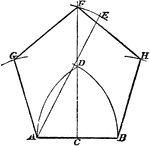Clipart tagged: ‘Regular’

Cone With Regular Polygon Inscribed and Circumscribed About
Illustration of a pyramid and with a regular polygon inscribed in and circumscribed about a cone. "If…
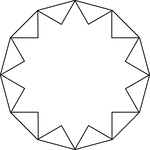
12-Point Star Inscribed In A Dodecagon
Illustration of a 12-point star (24-sided polygon) inscribed in a regular dodecagon. This can also be…

Centers of Equilateral Triangle
Illustration of an equilateral triangle that shows both the centroid (where the medians of the sides…
Construction of Regular Heptagon in a Circle
Illustration of beginning of construction of a regular heptagon in a circle.
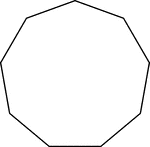
Regular Nonagon
Illustration of a regular nonagon. A nonagon is a closed geometric figure with 9 sides. A regular nonagon…
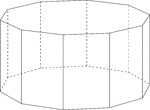
Decagonal Prism
Illustration of a decagonal prism with regular decagons for bases and rectangular faces. The hidden…
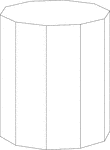
Decagonal Prism
Illustration of a right decagonal prism with regular decagons for bases and rectangular faces.

Decagonal Prism Resting On Its Side
Illustration of a right decagonal prism with regular decagons for bases and rectangular faces. The prism…
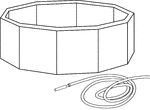
Swimming Pool Shaped Like A Decagonal Prism
Illustration of a swimming pool and water hose that is in the shape of a hollow regular decagonal prism…
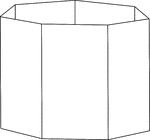
Heptagonal/Septagonal Prism
Illustration of a hollow right heptagonal/septagonal prism with regular heptagons/septagons for bases…
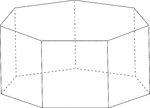
Heptagonal/Septagonal Prism
Illustration of a regular right heptagonal/septagonal prism with regular heptagons/septagons for bases…

Heptagonal/Septagonal Prism
Illustration of a right heptagonal/septagonal prism with regular heptagons/septagons for bases and rectangular…
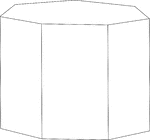
Heptagonal/Septagonal Prism
Illustration of a right heptagonal/septagonal prism with regular heptagons/septagons for bases and rectangular…
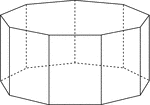
Nonagonal Prism
Illustration of a right nonagonal prism with regular nonagons for bases and rectangular faces. The hidden…
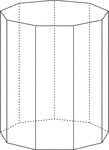
Nonagonal Prism
Illustration of a right nonagonal prism with regular nonagons for bases and rectangular faces. The height…
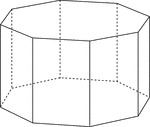
Octagonal Prism
Illustration of a right octagonal prism with regular octagons for bases and rectangular faces. The hidden…
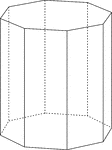
Octagonal Prism
Illustration of a right octagonal prism with regular octagons for bases and rectangular faces. The height…

Pentagonal Prism
Illustration of a right pentagonal prism with regular pentagons for bases and rectangular faces. The…
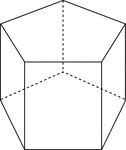
Pentagonal Prism
Illustration of a right pentagonal prism with regular pentagons for bases and rectangular faces. The…
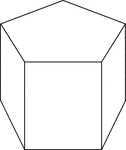
Pentagonal Prism
Illustration of a right pentagonal prism with regular pentagons for bases and rectangular faces. The…

Pentagonal Prism
Illustration of a right pentagonal prism with regular pentagons for bases and rectangular faces. The…

Similar Decagonal Prisms
Illustration of 2 similar right decagonal prisms. Both have regular decagons for bases and rectangular…
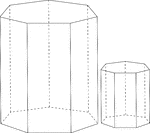
Similar Heptagonal/Septagonal Prisms
Illustration of 2 similar right heptagonal/septagonal prisms. Both have regular heptagons/septagons…

Similar Hexagonal Prisms
Illustration of 2 similar right hexagonal prisms. The height of the prism and length of the side of…

Decagonal Pyramid
Illustration of a right decagonal pyramid. The base is a decagon and the faces are isosceles triangles.…
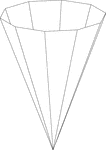
Inverted Decagonal Pyramid
Illustration of a hollow right decagonal pyramid. The base is a decagon and the faces are isosceles…

2 Right Pentagonal Pyramids
Illustration of 2 right pentagonal pyramids with hidden edges shown. The pentagonal bases are congruent,…
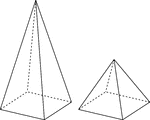
2 Right Rectangular Pyramids
Illustration of 2 right rectangular pyramids with hidden edges shown. The rectangular bases are congruent,…
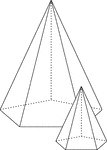
Similar Pentagonal Pyramids
Illustration of 2 similar right pentagonal pyramids with hidden edges shown. The height of the pyramid…

Regular Reflection
"Regular reflection results from the incidence of radiant energy upon a polished surface. When a beam…
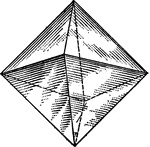
Regular Octahedron
"Science has succeeded in classifying the thousands of known crystals in six systems, to each of which…
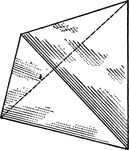
Regular Tetrahedron
"Science has succeeded in classifying the thousands of known crystals in six systems, to each of which…
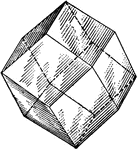
Rhombic Dodecahedron
"Science has succeeded in classifying the thousands of known crystals in six systems, to each of which…
